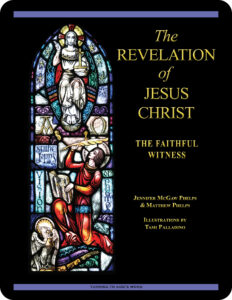 Glossary
Glossary
the book of Revelation
The following proper nouns name people and places mentioned in the biblical text for the Turning to God’s Word Catholic Bible study The Revelation of Jesus Christ: The Faithful Witness. Click on the locator maps to enlarge them.
The book of Revelation takes its English title from the Greek word “apocalypse,” which appears at the very beginning of the first chapter and means “an uncovering.” Because of the fantastic and sometimes bizarre images relating to the end of time, the word “apocalypse” has developed present-day connotation of cataclysmic disaster but this meaning would not have been intended by the author of the book of Revelation.
—A—
Abaddon—The Hebrew name for the angel of the bottomless pit; in Greek, the same angel is called Apollyon. Because the bottomless pit is synonymous with the abyss or formless void existing prior to Creation, Abaddon or Apollyon is considered to be a supernatural being who rules over destructive forces and is associated with Satan. The Hebrew word abaddon also can refer to Sheol, the abode of the dead. Lesson 10
Almighty—When capitalized as a noun, Almighty is a title that emphasizes the omnipotence and all-powerful nature of God. It is used throughout Scripture. Lessons 1, 5, 12, 16–17, 20, 22
Alpha—The first letter of the Greek alphabet. In the first chapter in the book of Revelation, God identifies himself as Alpha and Omega (the last letter of the Greek alphabet) to indicate that the divine presence encompasses all time from the beginning until the end. The book of Revelation repeatedly emphasizes that God exists outside of time. Lessons 1, 22–23
Amen—The word Amen, which appears throughout Scripture, comes from a Hebrew word meaning “certainty” or “truth.” Some translations of the New Testament render it as “verily.” The author of the book of Revelation uses the word Amen to emphasize the work’s focus on the truth. When Amen appears at the end of a prayer it means “so be it” or “I believe.” Lessons 1, 4, 6, 8, 20, 23
Antipas—A martyr named Antipas is mentioned in the second chapter in the book of Revelation. Tradition holds that Antipas was anointed as bishop of the early Church in Pergamum by the John the Apostle. The name Antipas means “for all or against all.” Lesson 3
Apollyon—The Greek name for the angel of the bottomless pit; in Hebrew the same angel is called Abaddon. Because the bottomless pit is synonymous with the abyss or formless void existing prior to Creation, Apollyon or Abaddon refers to a supernatural being who rules over destructive forces and is associated with Satan. Lesson 10
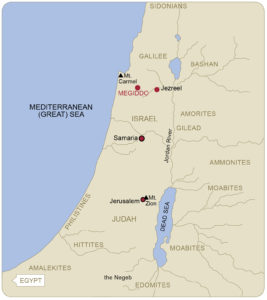 Armegeddon—In the sixteenth chapter in the book of Revelation, Armegeddon is identified as the location where forces opposed to God will gather for battle before Final Judgment. Armegeddon is a Greek transliteration of the Hebrew har megiddo, which means “mountain” or “range of hills” near Megiddo, an ancient Canannite fortress on the plains of Jezreel that was rebuilt by Ahab, ruler of the northern kingdom of Israel during the 9th century B.C., along the trade route linking Egypt and Assyria. The location figures in the account of the fall of the House of Ahab recorded in the ninth chapter in the Second Book of the Kings. The name Megiddo means “place of crowds.” Lesson 17
Armegeddon—In the sixteenth chapter in the book of Revelation, Armegeddon is identified as the location where forces opposed to God will gather for battle before Final Judgment. Armegeddon is a Greek transliteration of the Hebrew har megiddo, which means “mountain” or “range of hills” near Megiddo, an ancient Canannite fortress on the plains of Jezreel that was rebuilt by Ahab, ruler of the northern kingdom of Israel during the 9th century B.C., along the trade route linking Egypt and Assyria. The location figures in the account of the fall of the House of Ahab recorded in the ninth chapter in the Second Book of the Kings. The name Megiddo means “place of crowds.” Lesson 17
Asher—The eighth of Jacob’s 12 sons; Asher’s mother was Leah’s maid Zilpah. The name Asher means “happy.” The births of Asher’s 11 brothers are recorded in the twenty-ninth through thirtieth chapters and in the thirty-fifth chapter in the book of Exodus. The territory 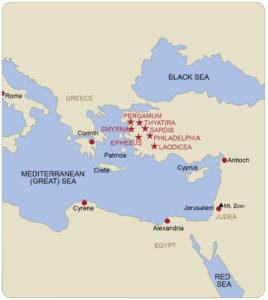 settled in the land of Canaan by the tribe of Asher became part of the northern kingdom of Israel. Lesson 8
settled in the land of Canaan by the tribe of Asher became part of the northern kingdom of Israel. Lesson 8
Asia—The largest of the world’s seven continents. Asia makes up the eastern portion of Eurasia; Europe makes up the western portion. The first chapter in the book of Revelation locates the seven churches in Asia to which the final book of the New Testament originally was addressed. Ephesus, Smyrna, Pergamum, Thyatira, Sardis, Philadelphia, and Laodicea originally were located in ancient Greece in what now is modern-day Turkey. Lesson 1
—B—
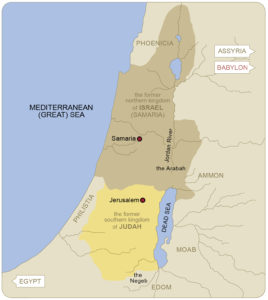 Babylon—The seventeenth chapter in the Second Book of the Kings identifies Babylon as one of five conquered kingdoms whose people were brought in to settle in the region of the northern kingdom of Israel after it fell to Assyria 722–721 B.C. Babylon replaced Assyria as the dominant power in the region and eventually conquered the southern kingdom, sending most of those inhabitants into exile in 597 and 587–586 B.C. The location of Babylon in southern Mesopotamia commonly is believed to have been the site of the tower of Babel (see the eleventh chapter in the book of Genesis). The city is located in present-day Iraq about 55 miles south of Baghdad. The name Babylon is related to the word Babel, which means “gate of the god.” In the book of Revelation, Babylon appears as an image of a harlot to represent all of the forces opposed to the people of God. Lessons 15, 17–19
Babylon—The seventeenth chapter in the Second Book of the Kings identifies Babylon as one of five conquered kingdoms whose people were brought in to settle in the region of the northern kingdom of Israel after it fell to Assyria 722–721 B.C. Babylon replaced Assyria as the dominant power in the region and eventually conquered the southern kingdom, sending most of those inhabitants into exile in 597 and 587–586 B.C. The location of Babylon in southern Mesopotamia commonly is believed to have been the site of the tower of Babel (see the eleventh chapter in the book of Genesis). The city is located in present-day Iraq about 55 miles south of Baghdad. The name Babylon is related to the word Babel, which means “gate of the god.” In the book of Revelation, Babylon appears as an image of a harlot to represent all of the forces opposed to the people of God. Lessons 15, 17–19
Balaam—In the twenty-second chapter in the book of Numbers, Balaam is asked by Balak, the king of Moab, to curse the descendants of Jacob who were camping on the plains of Moab after escaping slavery in Egypt. He refuses to do so. The problem with Balaam is not that he doesn’t speak the truth as it has been revealed to him by God—it’s that he persists in promoting the idea that other gods exist. The name Balaam means “ancient of the people” or “destruction of the people.” Lesson 3
Balak—In the twenty-second chapter in the book of Numbers, Balak, the king of Moab, asks Balaam to curse the descendants of Jacob who were camping on the plains of Moab after escaping slavery in Egypt. Balaam refuses to do so. The problem with Balaam is not that he doesn’t speak the truth as it has been revealed to him by God—it’s that he persists in promoting the idea that other gods exist. The name Balak means “who lays waste or destroys.” Lesson 3
Benjamin—The twelfth and youngest of Jacob’s sons; Benjamin’s mother was Rachel, who died in childbirth. The name Benjamin means “son of the right hand.” The births of Benjamin’s 11 brothers are recorded in the twenty-ninth through thirtieth chapters and in the thirty-fifth chapter in the book of Exodus. The territory settled in the land of Canaan by the tribe of Benjamin became part of the southern kingdom of Judah. Lesson 8
Bride—Introduced in the nineteenth chapter in the book of Revelation to refer to the Church as the new Jerusalem, the image of a Bride relies on nuptial imagery used by the Old Testament prophets and in the Gospel According to John to describe the union of the Church and Jesus Christ. Lessons 20, 22–23
—C—
Christ—A title derived from the Greek word Christos, which corresponds to the Hebrew word for Messiah and means “Anointed One.” Saying that Jesus is the Christ—or calling him Jesus Christ—is the same as identifying Jesus as God’s Anointed. Lessons 1, 12–13, 21
Church—When capitalized, the word Church refers to the universal Christian Church established by Jesus. Lowercase church refers to a building in which worship occurs. Lessons 3–4.
—D—
Dan—The fifth of Jacob’s 12 sons; Dan’s mother was Rachel’s maid Bilhah. The name Dan means “judge” or “God is my judge.” The births of Dan’s 11 brothers are recorded in the twenty-ninth through thirtieth chapters and in the thirty-fifth chapter in the book of Exodus. The territory settled in the land of Canaan by the tribe of Dan became part of the northern kingdom of Israel. Can you suggest a reason why the author of the book of Revelation intentionally might have failed to include Dan in the listing of the 12 tribes who will have members marked to indicate their service to God? Lesson 8
David—Details of David’s life are recorded in the sixteenth chapter in the First Book of Samuel through the second chapter in the First Book of the Kings. Born into the line of Judah, David was chosen by God to replace Saul as ruler over all of the descendants of Jacob. The seventh chapter in the Second Book of Samuel contains God’s promise to raise up one of David’s descendants as an eternal king. The name David means “beloved” or “friend.” The third chapter in the book of Revelation mentions the key of David as being in the possession of the one dictating the letter to the Church in Philadelphia. It’s significant to consider what it is that this key opens and shuts. Lessons 4, 6, 23
Death—In the first chapter in the book of Revelation, the Son of man announces that he holds the keys of Death and Hades. Death is capitalized to indicate that it’s to be understood as a personification. Both Death and Hades are personified in the sixth and twentieth chapters in the book of Revelation as well. Lessons 2, 7, 21
Devil—Devil (capped) is synonymous with Satan (also capped), considered the personification of evil. Lowercase, the two words usually refer to any of a number of lesser demons—devils or satans—that attempt to turn humanity away from God. That devil is lowercase on second reference in the twelfth chapter in the book of Revelation signifies his defeat at the hands of the angels led by Michael. The word devil derives from the Greek diabolos or “slanderer.” Lessons 13, 21
—E—
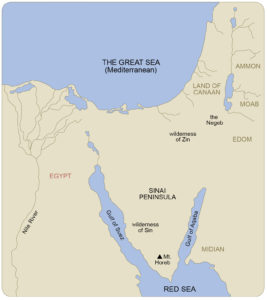 Egypt—The eleventh chapter in the book of Revelation identifies an allegorical “great city” where God’s two witnesses will die as Egypt and Sodom. The ninth chapter in the Book of Ezra identifies the Egyptians as one of the groups with whom God’s people had intermarried after the Babylonian Exile. The land of Egypt is territory surrounding the Nile River in the northeast corner of Africa. It was inhabited by descendants of Egypt, a son of Ham and grandson of Noah (see the tenth chapter in the book of Genesis). Egyptians appear throughout the Old Testament as enemies of God’s people; alternately the land of Egypt appears as a place of refuge, especially during times of famine. Scholars are uncertain of the meaning of the word Egypt, although it appears to be related to the idea of “place.” Lesson 12
Egypt—The eleventh chapter in the book of Revelation identifies an allegorical “great city” where God’s two witnesses will die as Egypt and Sodom. The ninth chapter in the Book of Ezra identifies the Egyptians as one of the groups with whom God’s people had intermarried after the Babylonian Exile. The land of Egypt is territory surrounding the Nile River in the northeast corner of Africa. It was inhabited by descendants of Egypt, a son of Ham and grandson of Noah (see the tenth chapter in the book of Genesis). Egyptians appear throughout the Old Testament as enemies of God’s people; alternately the land of Egypt appears as a place of refuge, especially during times of famine. Scholars are uncertain of the meaning of the word Egypt, although it appears to be related to the idea of “place.” Lesson 12
Ephesus—One of the seven churches to which the book of Revelation originally was addressed. Ephesus was located in ancient Greece in what now is present-day Turkey. The other six churches are Smyrna, Pergamum, Thyatira, Sardis, Philadelphia, and Laodicea. See map with entry for Asia. Lessons 2–3
Ephraim—The second of Joseph’s two sons born in Egypt. Their births are recorded in the forty-sixth chapter in the book of Genesis. The name Ephraim means “fruitful.” Ephraim and his brother Manasseh were adopted by their grandfather Jacob, and each received an inheritance in the land of Canaan. That territory later became part of the northern kingdom of Israel. Can you suggest a reason why the author of the book of Revelation intentionally might have included Manasseh in the listing of the 12 tribes who will have members marked to indicate their service to God but failed to include Ephraim? Lesson 8
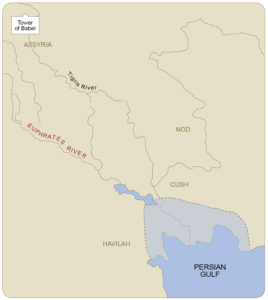 Euphrates—The longest river in Western Asia. It originates in Turkey and flows through Syria and Iraq to join the Tigris River before emptying into the Persian Gulf. The Tigris and Euphrates Rivers are named in the second chapter in the book of Genesis in connection with the Garden of Eden; the remaining two rivers named in that second biblical account of Creation apparently no longer exist. The area of Mesopotamia enclosed by the Tigris and Euphrates Rivers often is referred to as the “cradle of civilization” because of a belief that civilization first developed in that region. Lessons 10, 17
Euphrates—The longest river in Western Asia. It originates in Turkey and flows through Syria and Iraq to join the Tigris River before emptying into the Persian Gulf. The Tigris and Euphrates Rivers are named in the second chapter in the book of Genesis in connection with the Garden of Eden; the remaining two rivers named in that second biblical account of Creation apparently no longer exist. The area of Mesopotamia enclosed by the Tigris and Euphrates Rivers often is referred to as the “cradle of civilization” because of a belief that civilization first developed in that region. Lessons 10, 17
—F—
Faithful—One of the titles given the rider on the white horse when he reappears in the nineteenth chapter in the book of Revelation. The other title is True. Lesson 20
Father—When capitalized, Father always refers to God the Father. Lessons 1, 3–4
—G—
Gad—The seventh of Jacob’s 12 sons; Gad’s mother was Rachel’s maid Zilpah, The name Gad means “happiness,” “luck,” or “fortune.” The births of Gad’s 11 brothers are recorded in the twenty-ninth through thirtieth chapters and in the thirty-fifth chapter in the book of Exodus. The territory settled in the land of Canaan by the tribe of Gad became part of the northern kingdom of Israel. Lesson 8
Greek (language)—The ninth chapter in the book of Revelation discloses the Greek name of the angel of the bottomless pit—Apollyon—but the Hebrew name for the same angel—Abaddon—also is provided. This suggests that the author of the book of Revelation expected that not all of his original audience would be familiar with the Hebrew term. Lesson 10
God—Used throughout the book of Revelation to refer to God the Father. Lessons 1–23
God the Almighty—Adding Almighty to the title of God emphasizes the omnipotence and all-powerful nature of God. Lesson 20
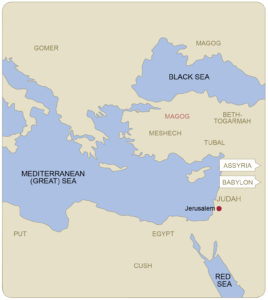 Gog—The thirty-eighth chapter in the Book of Ezekiel foretells the future defeat of Gog and Magog, a theme that the author of the twentieth chapter in the book of Revelation builds on to describe a final assault by evil forces at the end of time. Gog was the ruler of Magog, a territory far north of the area settled by the descendants of Jacob. It is believed to have been located somewhere in present-day Russia. The name Magog means “house of Gog.” The name of its ruler, Gog, means “roof.” Lesson 21
Gog—The thirty-eighth chapter in the Book of Ezekiel foretells the future defeat of Gog and Magog, a theme that the author of the twentieth chapter in the book of Revelation builds on to describe a final assault by evil forces at the end of time. Gog was the ruler of Magog, a territory far north of the area settled by the descendants of Jacob. It is believed to have been located somewhere in present-day Russia. The name Magog means “house of Gog.” The name of its ruler, Gog, means “roof.” Lesson 21
—H—
Hades—In the first chapter in the book of Revelation, the Son of man announces that he holds the keys of Death and Hades. The author of the book of Revelation takes pains to distinguish between the two. Hades is the abode of the dead named for the Greek god of the underworld. Sheol is the Hebrew name for the same concept. Although sometimes now considered synonymous with the Christian idea of hell, neither Hades nor Sheol originally were considered places of punishment. Both Death and Hades are personified in the sixth and twentieth chapters in the book of Revelationas well. Lessons 2, 7, 21
Hallelujah—The nineteenth chapter in the book of Revelation describes a great multitude in heaven crying Hallelujah at the divine victory over evil forces. Hallelujah comes from the Hebrew word Hallel, which means “praise the Lord” and is the name given to Psalms 113–118. These six Psalms are included in Jewish liturgy on all the major holy days except Rosh Hashana and Yom Kippur. Christian liturgies usually substitute the Latinized form of hallelujah, which is alleluia. Alleluia is not said in Catholic churches from the beginning of Lent until the celebration of Jesus Christ’s Resurrection at the Easter Vigil Mass. Lesson 20
Hebrew (language)—The ninth chapter in the book of Revelation discloses the Hebrew name of the angel of the bottomless pit—Abaddon—but the Greek name for the same angel—Apollyon—also is provided. This suggests that the author of the book of Revelation expected that not all of his original audience would be familiar with the Hebrew term. Lessons 10, 17
Holy One—The sixteenth chapter in the book of Revelation refers to God as the Holy One, a title that emphasizes both the holiness and oneness of God. Lesson 17
—I—
Issachar—The ninth of Jacob’s 12 sons; Issachar’s mother was Leah. The name Issachar means “his reward will come.” The births of Issachar’s 11 brothers are recorded in the twenty-ninth through thirtieth chapters and in the thirty-fifth chapter in the book of Exodus. The territory settled in the land of Canaan by the tribe of Issachar became part of the northern kingdom of Israel. Lesson 8
—J—
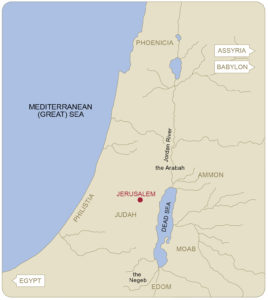 Jerusalem—Throughout most of the Old Testament, the descendants of Jacob recognize Jerusalem as their religious center. Originally a Jebusite stronghold, Jerusalem was conquered by David, who made it his capital city. The city and Temple were destroyed by the Babylonians in 587–586 B.C. and later rebuilt after the Persian ruler Cyrus in 538 B.C. allowed the captives to return to their homeland from Babylon. In the Old Testament, Jerusalem is referred to as the Holy City, Zion, city of Zion, or city of David. The name Jerusalem means “city of peace.” Most scholars consider references to the new Jerusalem in the book of Revelation to point to final union with God and not to a particular geographical location. Lessons 4, 22
Jerusalem—Throughout most of the Old Testament, the descendants of Jacob recognize Jerusalem as their religious center. Originally a Jebusite stronghold, Jerusalem was conquered by David, who made it his capital city. The city and Temple were destroyed by the Babylonians in 587–586 B.C. and later rebuilt after the Persian ruler Cyrus in 538 B.C. allowed the captives to return to their homeland from Babylon. In the Old Testament, Jerusalem is referred to as the Holy City, Zion, city of Zion, or city of David. The name Jerusalem means “city of peace.” Most scholars consider references to the new Jerusalem in the book of Revelation to point to final union with God and not to a particular geographical location. Lessons 4, 22
Jesus—The name of the second person of the Trinity. In the book of Revelation, use of the name Jesus without the addition of the word Christ to the title stresses the humanity of Jesus. Lessons 2, 13, 15, 18, 20–21, 23
Jesus Christ—A title given to Jesus indicating that he is the long-awaited Messiah promised by God to be born into the line of David (the tribe of Judah) and to rule over an eternal kingdom. The author of the book of Revelation only uses the name Jesus without specifying Jesus Christ in the first chapter in the book of Revelation. Lesson 1
Jews—People who practice Judaism, the religion founded on traditional Hebrew worship of the God of Abraham, Isaac, and Jacob, are Jews. Judaism developed after the fall of Jerusalem to Babylon in 587–586 B.C., which is when the term Jews began to be used. Prior to that, God’s people were identified by other names. Judahite is the correct way to describe members of the tribe of Judah. Descendants of Jacob who worshiped the God of their ancestors before the Babylonian Exile are properly identified as either Hebrews (descendants of Eber) or Israelites (descendants of Jacob/Israel). Those who worshiped the God described in the early chapters of the book of Genesis are properly identified as Hebrews (descendants of Eber). Significant biblical figures prior to the time of Eber (Adam and Eve, for example) can be referred to as early ancestors of the Hebrews. The use of the term Israelites only is valid after the time of Jacob/Israel. Lessons 3–4
Jezebel—In the book of Revelation 2:18–28, Jezebel (daughter of Ethbaal, king of Sidon) is mentioned by name in the letter to the angel of the Church in Thyatira. Here Jesus is making reference to someone whose behavior resembles that of the woman named Jezebel; her offensive actions are described in the eighteenth through twenty-first chapters in the First Book of the Kings. As the wife of Ahab, ruler of the northern kingdom of Israel, Jezebel opposed traditional Hebrew worship practices and was responsible for the deaths of many prophets of the LORD. Her own violent death is foreseen by the prophet Elijah in  the First Book of the Kings 21:17–25 and is described in the ninth chapter in the Second Book of the Kings. You can learn more about the reign of Ahab and his wife Jezebel over the northern kingdom of Israel in Thus Says the LORD: God Speaks Through His Servants the Prophets—Volume I: A Kingdom Divided. Surprisingly enough, the name Jezebel means “pure” or “virginal.” Lesson 3
the First Book of the Kings 21:17–25 and is described in the ninth chapter in the Second Book of the Kings. You can learn more about the reign of Ahab and his wife Jezebel over the northern kingdom of Israel in Thus Says the LORD: God Speaks Through His Servants the Prophets—Volume I: A Kingdom Divided. Surprisingly enough, the name Jezebel means “pure” or “virginal.” Lesson 3
John—In the first chapter in the book of Revelation, the author discloses his name to be John. Although the authorship of the final book of the Old Testament is uncertain, many scholars believe that it was written by the disciple of the same name, who also is credited with writing the Gospel According to John. Lessons 1–2, 23
Joseph—The eleventh of Jacob’s 12 sons; Joseph’s mother was Rachel. The name Joseph means “God will give.” The births of Joseph’s 11 brothers are recorded in the twenty-ninth through thirtieth chapters and in the thirty-fifth chapter in the book of Exodus. Instead of receiving an inheritance in Canaan, Joseph’s share instead was given to his Egyptian-born sons Ephraim and Mahnasseh. The territory settled in the land of Canaan by those tribes became part of the northern kingdom of Israel. Lesson 8
Judah—The twenty-ninth through thirty-fifth chapters in the book of Genesis describe details in the life of Judah, fourth of the 12 sons of Jacob. Judah’s mother was Leah. The name Judah means “praised.” The fifth chapter of the book of Revelation refers to Jesus as the Lion of the tribe of Judah (the lion is an image for Judah taken from Jacob’s farewell address in the forty-ninth chapter in the book of Genesis), the Root of David (an image that points to Jesus as the Messiah in the line of David), and the Lamb (a title for Jesus used in the Gospel According to John). Geographically, Judah refers to territory in the land of Canaan settled by the tribe of Judah. After the death of Solomon, the 10 tribes split away from the united kingdom. The southern kingdom, made up of the tribes of Judah and Benjamin, took the name Judah. It fell to the Babylonians in 587–586 B.C. Lessons 6, 8
—K—
King—In the first chapter in the Book of Malachi, God announces that he is a great King, an Old Testament title that emphasizes how it is that God would like to be thought of by his people. In the fifteenth chapter in the book of Revelation, God is hailed as King of the ages. Lesson 16
King of kings—This title is applied to the Lamb in the seventeenth and nineteenth chapters in the book of Revelation. The repetition in King and kings and Lord and lords indicates that the Lamb is superior to any human kings or lords. Lessons 18, 20
—L—
Lamb—The fifth chapter in the book of Revelation refers to a Lamb who is found worthy to open the mysterious scroll in heaven. The fifty-third chapter in the Book of Isaiah, one of the Servant Songs written by the author known as Deutero- or Second Isaiah, points to a connection between the prophesied Messiah and the Passover lamb described in the twelfth chapter in the book of Exodus. The first chapter in the Gospel According to John uses the image of a Lamb for Jesus, and this is reflected in the image of the Lamb standing as though slain in the book of Revelation. The twenty-first chapter in the book of Revelation records that the 12 foundations of the new Jerusalem are inscribed with the names of the 12 apostles of the Lamb. Lessons 6–9, 13–16, 18, 20, 22–23
Laodicea—One of the seven churches in Asia to which the book of Revelation originally was addressed. Laodicea was located in ancient Greece in what now is present-day Turkey. The other six churches are Ephesus, Smyrna, Pergamum, Thyatira, Sardis, and Philadelphia. See map with entry for Asia. Lessons 2, 4
Levi—The third of Jacob’s 12 sons; Levi’s mother was Leah. The name Levi means “joined” or “joined in harmony.” The births of Levi’s 11 brothers are recorded in the twenty-ninth through thirtieth chapters and in the thirty-fifth chapter in the book of Exodus. The tribe of Levi, anointed by God to provide hereditary priests in the line of Aaron, did not inherit property in the land of Canaan, even though descendants of all of the other sons of Jacob did. Lesson 8
Lion—The twenty-ninth through thirty-fifth chapters in the book of Genesis describe details in the life of Judah, fourth of the 12 sons of Jacob. The tribe of Judah refers to descendants of Judah. The name Judah means “praise.” The fifth chapter of the book of Revelation refers to Jesus as the Lion of the tribe of Judah (the lion is an image for Judah taken from Jacob’s farewell address in the forty-ninth chapter in the book of Genesis) and the Root of David. Lesson 6
Lord—The author’s use of the title Lord (regular upper and lowercase letters) in the eleventh, fourteenth, and fifteenth chapters in the book of Revelation appears uncharacteristically inconsistent. The intention may be to emphasize that Jesus and the Father are one. Lessons 12, 15–16, 23
Lord God—In the book of Revelation, the title Lord God is used to emphasize that God is master and the same God worshiped by the patriarchs Abraham, Isaac, and Jacob. Throughout the Old Testament, a variety of words refer to God. Some translations, including the Revised Standard Version—Second Catholic Edition (RSV2CE) and the New American Bible Revised Edition (NABRE), use small capital letters for LORD to designate Yahweh, the most sacred name of God. The word God is used to designate Elohim, a word that emphasizes the strength of God’s divinity. A third word, Adonai, usually indicated by Lord (regular upper and lowercase letters), also is used as a name for God and refers to God as master. In Turning to God’s Word printed Catholic Bible studies, small capital letters are used when LORD translates Yahweh; because small capital letters are not an option on the website, Turning to God’s Word website materials use all capital letters (LORD) to differentiate Yahweh from Elohim or Adonai. In the New Testament, Lord (regular upper and lowercase letters) also is used as a title for Jesus. Lessons 1, 5, 19, 23
Lord God Almighty/ Lord God the Almighty/Lord our God the Almighty—Adding Almighty to the title Lord God emphasizes the omnipotence and all-powerful nature of God. Lessons 5, 12, 16–17, 20, 22
Lord Jesus—The twenty-second chapter in the book of Revelation directly connects the title Lord to the name of Jesus. Lesson 23
Lord’s day—In the first chapter in the book of Revelation, John of Patmos writes that it was on the Lord’s day when he experienced his apocalyptic vision of heaven. The first and eighth day of the week (Sunday), celebrated by Christians as the day of Jesus’ Resurrection, replaces the Jewish sabbath, celebrated on the seventh day when God rested after creating the world. Lesson 2
Lord of lords— This title is applied to the Lamb in the the seventeenth and nineteenth chapters in the book of Revelation. The repetition in Lord and lords and King of kings indicates that the Lamb is superior to any human kings or lords. Lessons 18, 20
—M—
 Magog—The thirty-eighth chapter in the Book of Ezekiel foretells the future defeat of Gog and Magog, a theme that the author of the twentieth chapter in the book of Revelation builds on to describe a final assault by evil forces at the end of time. Gog was the ruler of Magog, a territory far north of the area settled by the descendants of Jacob. It is believed to have been located somewhere in present-day Russia. The name Magog means “house of Gog.” The name of its ruler, Gog, means “roof.” Lesson 21
Magog—The thirty-eighth chapter in the Book of Ezekiel foretells the future defeat of Gog and Magog, a theme that the author of the twentieth chapter in the book of Revelation builds on to describe a final assault by evil forces at the end of time. Gog was the ruler of Magog, a territory far north of the area settled by the descendants of Jacob. It is believed to have been located somewhere in present-day Russia. The name Magog means “house of Gog.” The name of its ruler, Gog, means “roof.” Lesson 21
Manasseh—The first of Joseph’s two sons born in Egypt. Their births are recorded in the forty-sixth chapter in the book of Genesis. The name Manasseh means “making forgetfulness.” Manasseh and his brother Ephraim were adopted by their grandfather Jacob, and each received an inheritance in the land of Canaan. That territory later became part of the northern kingdom of Israel. Can you suggest a reason why the author of the book of Revelation intentionally might have included Manasseh in the listing of the 12 tribes who will have members marked to indicate their service to God but failed to include Ephraim? Lesson 8
Michael—The twelfth chapter in the book of Revelation refers to an angel named Michael, commonly considered to be the archangel Michael, leading other angels in a battle against a dragon that represents a threat to humanity. The name Michael means “who is like God?” Lesson 13
Moses—References to Moses, a man called by God to lead the descendants of Jacob out of slavery in Egypt, appear throughout Scripture. The book of Exodus describes events in his life. Religious law was given by God to Moses in the form of the 10 Commandments, and Moses foretold that at some future date the LORD would raise up another prophet like him. The name Moses means “to deliver from the water.” The fifteenth chapter in the book of Revelation makes mention of the song of Moses, which the descendants of Jacob sang in celebration after escaping from the Egyptians. The Old Testament includes two songs of Moses—one in the book of Exodus 15:1–18 and the other in the book of Deuteronomy 32:1–43. Lesson 16
Mount Zion—The Old Testament makes frequent mention of Mount Zion, the elevation on which Jerusalem is built, and the city of Jerusalem and its temple occasionally are referred to as Zion or Mount Zion. The name Zion means “monument” or “raised up.” Lesson 15
—N—
Naphtali—The sixth of Jacob’s 12 sons; Naphtali’s mother was Rachel’s maid Bilhah. The name Naphtali means “my wrestling.” The births of Naphtali’s 11 brothers are recorded in the twenty-ninth through thirtieth chapters and in the thirty-fifth chapter in the book of Exodus. The territory settled in the land of Canaan by the tribe of Naphtali became part of the northern kingdom of Israel. Lesson 8
Nicolaitans—The sect of the Nicolaitans subscribed to a Gnostic heresy that emphasized the mercy of God as the basis of salvation while maintaining that sin was permissible because the law of God no longer was binding on Christians. In the present day, Gnosticism is a heresy that attracts people who seek salvation and power through acquisition of knowledge, often secretive. Lesson 3
—O—
Omega—The last letter of the Greek alphabet. In the first chapter in the book of Revelation, God identifies himself as Alpha (the first letter of the Greek alphabet) and Omega to indicate that the divine presence encompasses all time from the beginning until the end. The book of Revelation repeatedly emphasizes that God exists outside of time. Lessons 1, 22–23
—P—
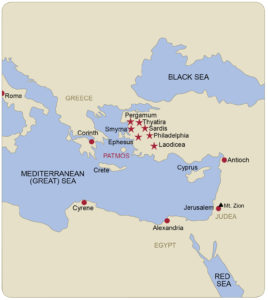 Patmos—In the first chapter in the book of Revelation, the author identifies himself as a man named John who is on Patmos, a small island in the Aegean Sea that served as a Roman penal colony. John writes that he has been consigned there “on account of the word of God and the testimony of Jesus.” The word Patmos means “to step upon.” Lesson 2
Patmos—In the first chapter in the book of Revelation, the author identifies himself as a man named John who is on Patmos, a small island in the Aegean Sea that served as a Roman penal colony. John writes that he has been consigned there “on account of the word of God and the testimony of Jesus.” The word Patmos means “to step upon.” Lesson 2
Pergamum—One of the seven churches to which the book of Revelation originally was addressed. Pergamum was located in ancient Greece in what now is present-day Turkey. The other six churches are Ephesus, Smyrna, Thyatira, Sardis, Philadelphia, and Laodicea. See map with entry for Asia. Lessons 2–3
Philadelphia—One of the seven churches to which the book of Revelation originally was addressed. Philadelphia was located in ancient Greece in what now is present-day Turkey. The other six churches are Ephesus, Smyrna, Pergamum, Thyatira, Sardis, and Laodicea. See map with entry for Asia. Lessons 2, 4
—Q—
—R—
Reuben—The eldest or firstborn of Jacob’s 12 sons; Reuben’s mother was Leah. The name Reuben means means “behold, a son.” The births of Reuben’s 11 brothers are recorded in the twenty-ninth through thirtieth chapters and in the thirty-fifth chapter in the book of Exodus. The territory settled in the land of Canaan by the tribe of Reuben became part of the northern kingdom of Israel. Lesson 8
Root of David—The fifth chapter in the book of Revelation refers to Jesus as the Root of David (an image that points to Jesus as the Messiah in the line of David. Jesus also is referred to as the Lion of the tribe of Judah (an image taken from Jacob’s farewell address in the forty-ninth chapter in the book of Genesis). Lesson 6
—S—
Sardis—One of the seven churches in Asia to which the book of Revelation originally was addressed. Sardis was located in ancient Greece in what now is present-day Turkey. The other six churches are Ephesus, Smyrna, Pergamum, Thyatira, Philadelphia, and Laodicea. See map with entry for Asia. Lessons 2, 4
Satan—The book of Revelation emphasizes Satan’s role as an accuser or legal adversary. A personification of evil, Satan frequently is portrayed as a a fallen angel banished from heaven for refusing to serve God. The twelfth chapter in the book of Revelation signifies his defeat at the hands of angels led by Michael. The name Satan means “adversary.” Lessons 3–4, 13, 21
Simeon—The second of Jacob’s 12 sons; Simeon’s mother was Leah. The name Simeon means “to hear,” “to be heard,” or “reputation.” The births of Simeon’s 11 brothers are recorded in the twenty-ninth through thirtieth chapters and in the thirty-fifth chapter in the book of Exodus. Territory eventually inhabited in the land of Canaan by the tribe of Simeon became part of the northern kingdom of Israel. Lesson 8
Smyrna—One of the seven churches to which the book of Revelation originally was addressed. Smyrna was located in ancient Greece in what now is present-day Turkey. The other six churches are Ephesus, Pergamum, Thyatira, Sardis, Philadelphia, and Laodicea. See map with entry for Asia. Lessons 2–3
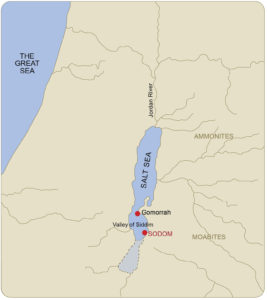 Sodom— The eleventh chapter in the book of Revelation identifies an allegorical “great city” where God’s two witnesses will die as Egypt and Sodom. The nineteenth chapter in the book of Genesis recounts the story of Sodom and Gomorrah, two ancient cities destroyed by God because of the excessive wickedness and depravity of their inhabitants. Sodom was located on what is now the southern edge of the the Salt (Dead) Sea. Archaeologists believe that the ancient boundaries of this body of water extended farther south. The name Sodom refers to any place known for vice and corruption, and is the root of the English word sodomy. Lesson 12
Sodom— The eleventh chapter in the book of Revelation identifies an allegorical “great city” where God’s two witnesses will die as Egypt and Sodom. The nineteenth chapter in the book of Genesis recounts the story of Sodom and Gomorrah, two ancient cities destroyed by God because of the excessive wickedness and depravity of their inhabitants. Sodom was located on what is now the southern edge of the the Salt (Dead) Sea. Archaeologists believe that the ancient boundaries of this body of water extended farther south. The name Sodom refers to any place known for vice and corruption, and is the root of the English word sodomy. Lesson 12
Son of God—In the second chapter in the book of Revelation, the person dictating the letter to the Church in Thyatira is identified as the Son of God (Jesus). Lesson 3
Son of man—When son of man is lower-cased in the prophetic Old Testament Books of Ezekiel, Isaiah, and Daniel, the term emphasizes the distinction between mortals and God. When Son of man is capitalized in the New Testament book of Revelation, it continues to emphasize the distinction between mortals and God, but by repeating the way the title is used in the Gospel According to John, the book of Revelation points to the Son of God being both human and divine. Lesson 2
sons of Israel—Readers who encounter the term sons of Israel in Scripture should pause to determine from context whether the author of the particular work intended sons of Israel to refer to descendants of all 12 of the tribes of Jacob, to descendants of the 10 tribes who had inhabited the former northern kingdom of Israel, or to descendants of the two tribes who had inhabited the former southern kingdom of Judah. The 12 sons of Israel listed in the seventh chapter in the book of Revelation vary from all other listings of Jacob’s progeny. Can you figure out why this list is so different? The twenty-first chapter in the book of Revelation records that the 12 gates to the new Jerusalem are inscribed with the names of the 12 tribes of the sons of Israel. The twenty-first chapter in the book of Revelation also records that the 12 foundations of the new Jerusalem are inscribed with the names of the 12 apostles of the Lamb. Lessons 7, 22
Sovereign Lord—The word sovereign means “having supreme power.” Capitalizing Sovereign and including it as part of the title for God—Sovereign Lord—emphasizes the authority of God. Lesson 7
Spirit—Throughout Scripture, Spirit—a word related to breathing and inspiration—is capitalized to refer to the soul or essence of God. Lessons 2–5, 15, 18, 22–23
spirits of God—The third chapter in the book of Revelation indicates that there are seven spirits of God in the possession of the person dictating the letter to the Church in Sardis. A few commentaries suggest that the seven spirits are synonymous with the seven gifts of the Holy Spirit, although that interpretation would involve subdividing the third person of the Holy Trinity into seven personified gifts. It appears that the author of the book of Revelation instead intends to present the seven spirits of God as seven non-corporeal beings (angels) who hang out close to the throne in heaven, but who are not equivalent to the Holy Spirit. (As one of the three divine persons in the Holy Trinity, the Holy Spirit would be equivalent with God and so would be on the throne, not near it.) The addition of Jesus makes that a grouping of spirits an eight, suggesting that Jesus is leading to perfection of worship in heaven as well as perfection of worship on earth. Lessons 4–6
—T—
Thyatira—One of the seven churches to which the book of Revelation originally was addressed. Thyatira was located in ancient Greece in what now is present-day Turkey. The other six churches are Ephesus, Smyrna, Pergamum, Sardis, Philadelphia, and Laodicea. See map with entry for Asia. Lessons 2–3
True—One of the titles given the rider on the white horse when he reappears in the nineteenth chapter in the book of Revelation. The other title is Faithful. Lesson 20
—U—
—V—
—W—
Word of God—This title for Jesus is used by the author of the Gospel According to John to emphasize the connection between God and divine inspiration (inspiration or spirit is necessary to form a word). The term Word of God also emphasizes that God’s speech is performative, that is, whatever God says happens. Finally, the term Word of God links Jesus to the Greek concept of logos, a complex word that in its most simple definition means “word.” Word of God generally is capitalized when it refers to Jesus or to Scripture. In the first chapter in the book of Revelation, word of God is lowercase to indicate that John has been exiled to the island of Patmos because of his unwavering adherence to Christianity, a religion still in its very early stages. Lesson 20
Wormwood—The biblical Hebrew word translated into English as “wormwood” is related to bitterness. As used in the eighth chapter in the book of Revelation, Wormwood is capitalized on the first reference as the name of the star fallen from heaven, but it’s lowercase on the second reference indicates that the contamination of the fresh water on earth by this star is similar to that caused by the moderately poisonous plant wormwood. In the book of Revelation the water is made bitter and causes the deaths of many. Lesson 9
—X—
—Y—
—Z—
Zebulun—The tenth of Jacob’s 12 sons; Zebulun’s mother was Leah. The name Zebulun means “dwelling of honor.” The births of Zebulun’s 11 brothers are recorded in the twenty-ninth through thirtieth chapters and in the thirty-fifth chapter in the book of Exodus. The territory settled in the land of Canaan by the tribe of Issachar became part of the northern kingdom of Israel. Lesson 8
